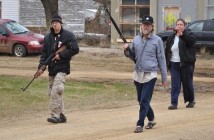
Cast: Viggo Mortensen, Maria Bello, Ed Harris
Director: David Cronenberg
Country: USA | Germany
Genre: Crime | Drama | Thriller
Official Trailer: Here
Editor’s Notes: The following review is part of our coverage for TIFF’s From Within: The Films of David Cronenberg which runs from November 1st to January 19th at TIFF Bell Lightbox. For more information on upcoming TIFF film series visit http://tiff.net and follow TIFF on Twitter at @TIFF_NET.
David Cronenberg is an avid Darwinian. There’s a moment about halfway through A History of Violence, his 2005 investigation into man’s recessive psyche, that hints toward just what sort of movie it is. Jack (Ashton Holmes), son of main man Tom Stall (Viggo Mortensen), incapacitates the sidekick bully with a swift kick to the groin and proceeds to pummel the ringleading jock-douchebag. Little in the high school conflict has changed between the earlier scene where Jack wards off jock-douchebag’s alpha-male aggression with quivering sarcasm and this ass-whooping that dares us to find catharsis.
The only difference, in fact, is that earlier, Jack’s dad is a simple diner owner in idyllic Millbrook, Indiana. He’s the sort of man everyone loves, who houses that most familiar mid-American familial perfection. His kids are caring and his lawyer wife, Edie (Maria Bello, exceeding her material), emanates the plainspoken confidence and restrained sexuality of a Midwestern gem. He speaks kindly and humbly, little but compassion or sincerity inflecting his voice. Then he kills a pair of fellas, tipping off to Jack that he has a genome rather useful for when he finds himself backed into a corner.
 Granted, those fellas are worse than even the most intense bullies. Late one night as Tom’s closing up, the two men hold up the diner. They threaten one waitress with rape and make clear, with their deathly eyes and hungry demands for the little cash in the diner, that every other man and woman would be shot dead. Tom stops them. Immediately, in a town which likely gets most of its excitement from Sunday duck races, Tom’s a hero. He thwarted evil men with evil intentions toward people who, the sheriff will tell you, take pride in “looking out for each other.” Initially, the smooth choreographic efficiency of Tom’s self-defense goes unnoticed.
Granted, those fellas are worse than even the most intense bullies. Late one night as Tom’s closing up, the two men hold up the diner. They threaten one waitress with rape and make clear, with their deathly eyes and hungry demands for the little cash in the diner, that every other man and woman would be shot dead. Tom stops them. Immediately, in a town which likely gets most of its excitement from Sunday duck races, Tom’s a hero. He thwarted evil men with evil intentions toward people who, the sheriff will tell you, take pride in “looking out for each other.” Initially, the smooth choreographic efficiency of Tom’s self-defense goes unnoticed.
The ambivalence doesn’t last. The sheriff begins to pry after a trio of men affiliated with an East coast crime syndicate show up at the diner. They accuse Tom of being someone else, an old-hand in their trade. The sheriff follows up, but briefly, distrusting of his gut. The gangsters are not so easily turned away. Carl Fogarty (Ed Harris), the threesome’s leader whose left eye was rendered disfigured and near useless by a mishap involving barbed wire, persists that Tom—or “Joey,” as he calls Tom—return with them to Philadelphia. Tom refuses, apparently clueless as to who these men are, and so the gangsters must encroach.
Cronenberg pulls a subtle bait and switch. A History of Violence opens with those two-bit robbers clearing out from a roadside motel. With the rest of their stuff, they toss tied plastic bags into the back of their convertible. One of them goes to the office to check out, the other waits outside. The camera’s still. There’s no sound coming from the office. When the man emerges, he sends the one who’d waited back inside to refill their jug of water. We know this formula: ominously clean plastic bags plus a guy in a suit who had “trouble” with the maid. All the blood we could’ve suspected waits inside that office. And that second fella—he shoots a kid. These are violent men, seasoned in mercilessness and armed theft. They also have nothing to do with the larger system of crime in the shadows of the rest of the film.
By opening with this scene, Cronenberg orchestrates a supposition of ours: that micro-organized crime here must tie into macro-organized there. It’s standard procedure for any film dabbling with Hitchcock’s Wrong Man, where, by a series of misconceptions and convolution, the innocent protagonist is mistakenly targeted by dangerous men or accused of dubious actions. However, the opening is really a prologue, establishing theme and backstory so that the tonal fissure to come remains coherent as it shocks.
Cronenberg peels back layer after layer of subversion from the script, until he turns it onto itself.
Every news station is throwing on screen Tom’s picture. He occupies the paper’s front page. The proceeding gangsters sent to corral Tom aren’t out for vengeance. They’re fetching a runaway: Joey. Fogarty and his henchmen invade Tom’s life more and more, until they pick up Jack and swap him as ransom for Tom’s compliance. Tom finally dispatches them, killing not only the gangsters, but any deniability he’d held too. Tom implores Edie that he spent three years in the desert killing Joey. His heroic spat of violence, though, reopens his history with it. He leaves voluntarily to once and for all sever from himself the life he’d abandoned.
Cronenberg peels back layer after layer of subversion from the script, until he turns it onto itself. The violence comes emphatically in the latter half of the movie (not always of the bloodletting sort, unless raw backs and knees from a staircase count) and in consistently predictable scenarios—scenarios that increasingly stretch suspended disbelief. Tom slugs his way out of predicaments he has no business surviving. It’s a sort of procession commonplace in mainstream actioners. We even get a bad guy missing a target which a toddler could accidentally bull’s-eye.
However, Cronenberg’s execution turns the material into something entirely unconventional. In Hollywood or other mainstream action movies, violence is often operatic, demanding balletic grace and precision no matter how chaotic or gruesome. But the mayhem in A History of Violence is brutal, abrupt, and unflinching. Bullets pop through flesh and bone without irony. Blood splatters with the raw crunch of a heavyweight jab. While jarring, the violence is matter-of-fact—a reminder that well-wielded fists really hurt and men truly kill, but that fury isn’t always the motivator. What needs to be done is what’s done.
 It’s the Darwinian in Cronenberg coming out again. Even Tom’s most gory actions are done for the sake of survival—his and his family’s. (Though the film’s eight years old: explicit spoilers ahead.) His emotions run deeper (and more complexly) than his unenviable familiarity with killing. The sheriff was halfway there with his inquiries into Tom belonging to the witness protection program. Tom Stall used to be Joey Cusack, mobster and “wild man” extraordinaire. At no point does Mortensen play Tom like damaged goods. He just now sees the “benefit” to a different life—a life dedicated to his wife and children and the simplicity of community.
It’s the Darwinian in Cronenberg coming out again. Even Tom’s most gory actions are done for the sake of survival—his and his family’s. (Though the film’s eight years old: explicit spoilers ahead.) His emotions run deeper (and more complexly) than his unenviable familiarity with killing. The sheriff was halfway there with his inquiries into Tom belonging to the witness protection program. Tom Stall used to be Joey Cusack, mobster and “wild man” extraordinaire. At no point does Mortensen play Tom like damaged goods. He just now sees the “benefit” to a different life—a life dedicated to his wife and children and the simplicity of community.
It’s a whiplash of a movie, the taut pacing no hurdle for Cronenberg’s effective inversion of tone. He establishes so much of the town and the mood with the sort of streetlamp swoops we’d expect from a Gilmore Girls episode. That’s abandoned as the narrative alters from small town idealism to that of a noir Western, all corners and scene setting. Cronenberg peppers up the film for its final showdown (in a late but critical role, William Hurt provides a resounding and vital turn). He can’t help but raise questions from every possible vantage, calling into consideration how we define love, the worthiness of its evolution, personal limits, and identity and self. It’s a bold and memorable film—if for none of the reasons detailed above, then for its equally steady footing as both an art and plot-centric thriller.
[notification type=“star”]83/100 ~ GREAT. It’s a whiplash of a movie—if for none of the reasons detailed above, then for its equally steady footing as both an art and plot-centric thriller.[/notification]



